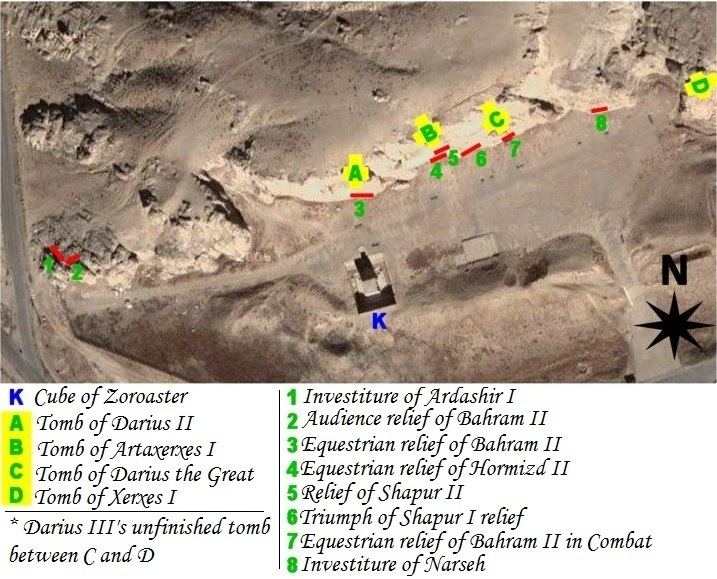Location Fars Province, Iran Cultures Persian Phone +98 81 6720 9275 | Type Necropolis Address Fars Province, Iran | |
 | ||
Burials Darius I, Xerxes I, Artaxerxes I of Persia, Bahram II, Narseh, Hormizd II, Hormizd I, Sogdianus of Persia, Peroz I, Parysatis Periods Achaemenid Empire, Sasanian Empire Similar Naqsh‑e Rajab, Ka'ba‑ye Zartosht, Arg of Karim Khan, Eram Garden, Tomb of Hafez | ||
Naqsh-e Rustam (Persian: نقش رستم [ˌnæɣʃeɾosˈtʰæm]) is an ancient necropolis located about 12 km northwest of Persepolis, in Fars Province, Iran, with a group of ancient Iranian rock reliefs cut into the cliff, from both the Achaemenid and Sassanid periods. It lies a few hundred meters from Naqsh-e Rajab, with a further group of Sassanid reliefs.
Contents
- the 4 tombs in naqsh e rustam iran necropolis
- Monuments
- Achaemenid tombs
- Kaba ye Zartosht
- Sassanid reliefs
- Archaeology
- References
the 4 tombs in naqsh e rustam iran necropolis
Monuments
The oldest relief at Naqsh-e Rustam dates back to c. 1000 BC. Though it is severely damaged, it depicts a faint image of a man with unusual head-gear, and is thought to be Elamite in origin. The depiction is part of a larger mural, most of which was removed at the command of Bahram II. The man with the unusual cap gives the site its name, Naqsh-e Rustam ("Rustam Relief" or "Relief of Rustam"), because the relief was locally believed to be a depiction of the mythical hero Rustam.
Achaemenid tombs
Four tombs belonging to Achaemenid kings are carved out of the rock face at a considerable height above the ground. The tombs are sometimes known as the Persian crosses, after the shape of the facades of the tombs. The entrance to each tomb is at the center of each cross, which opens onto to a small chamber, where the king lay in a sarcophagus. The horizontal beam of each of the tomb's facades is believed to be a replica of a Persepolitan entrance.
One of the tombs is explicitly identified, by an accompanying inscription, as the tomb of Darius I (c. 522-486 BC). The other three tombs are believed to be those of Xerxes I (c. 486-465 BC), Artaxerxes I (c. 465-424 BC), and Darius II (c. 423-404 BC) respectively. The order of the tombs in Naqsh-e Rustam follows (left to right): Darius II, Artaxerxes I, Darius I, Xerxes I.
A fifth unfinished one might be that of Artaxerxes III, who reigned at the longest two years, but is more likely that of Darius III (c. 336-330 BC), the last king of the Achaemenid Dynasts. The tombs were looted following the conquest of the Achaemenid Empire by Alexander the Great.
Ka'ba-ye Zartosht
Ka'ba-ye Zartosht (meaning the "Cube of Zoroaster") is a 5th century BCE Achaemenid square tower. The structure is a copy of a sister building at Pasargadae, the "Prison of Solomon" (Zendān-e Solaymān). It was built either by Darius I (r. 521–486 BCE) when he moved to Persepolis, by Artaxerxes II (r. 404–358 BCE) or Artaxerxes III (r. 358–338 BCE). The building at Pasargadae is a few decades older. The wall surrounding the tower dates to Sassanid times.
Several theories exist regarding the purpose of the Ka'ba-ye Zartosht structure.
Sassanid reliefs
Seven over-lifesized rock reliefs at Naqsh-e Rustam depict monarchs of the Sassanid period.
Archaeology
In 1923, the German archaeologist Ernst Herzfeld made casts of the inscriptions on the tomb of Darius I. Since 1946, these casts have been held in the archives of the Freer Gallery of Art and the Arthur M. Sackler Gallery, Smithsonian Institution, in Washington, DC.
Naqsh-e Rustam was excavated for several seasons between 1936 and 1939 by a team from the Oriental Institute of the University of Chicago, led by Erich Schmidt.
